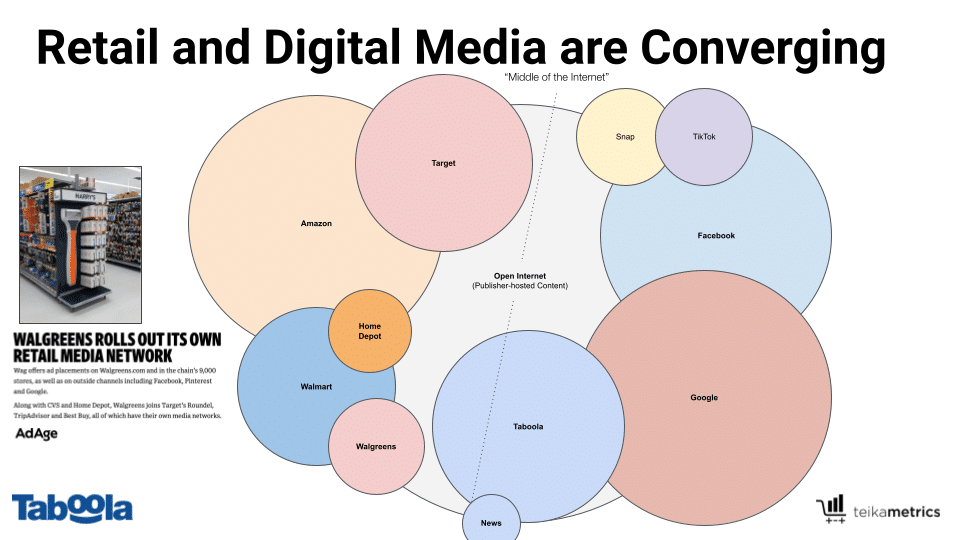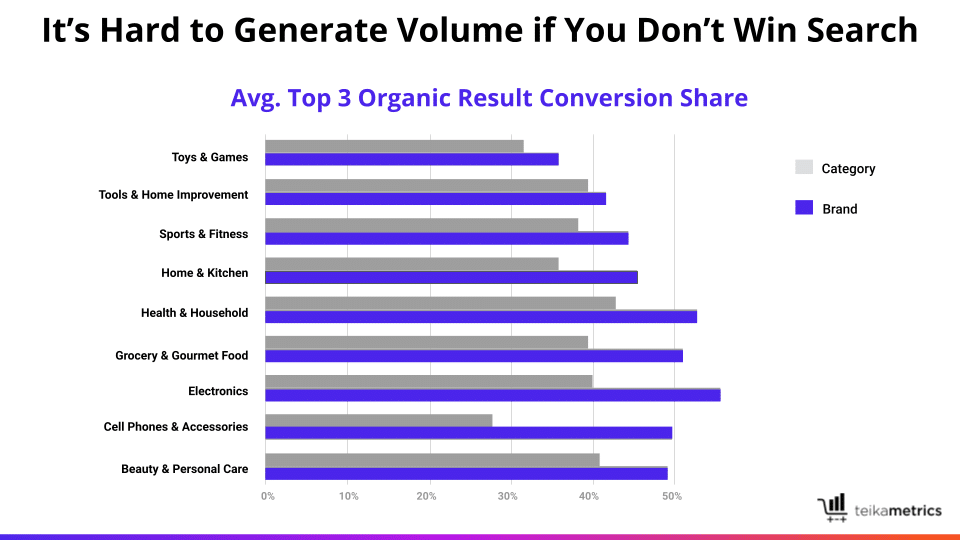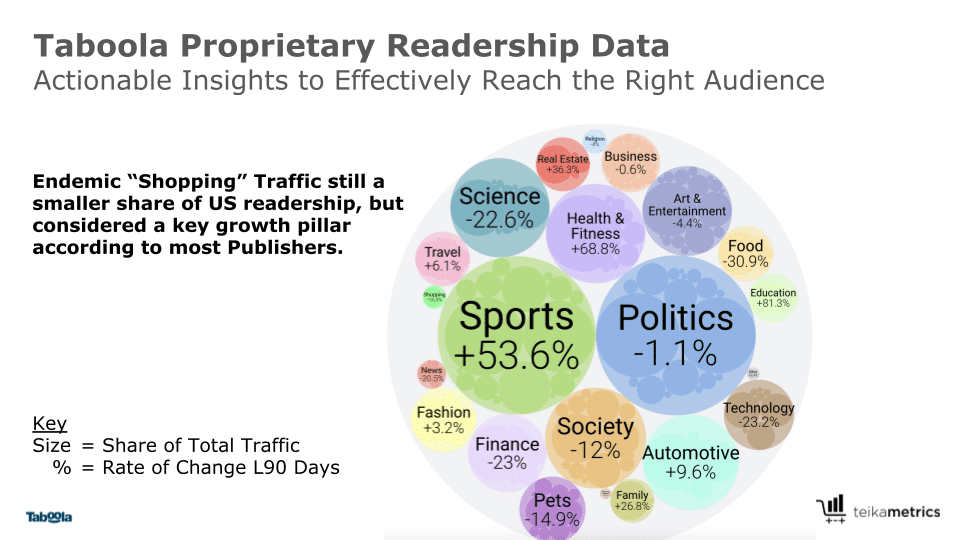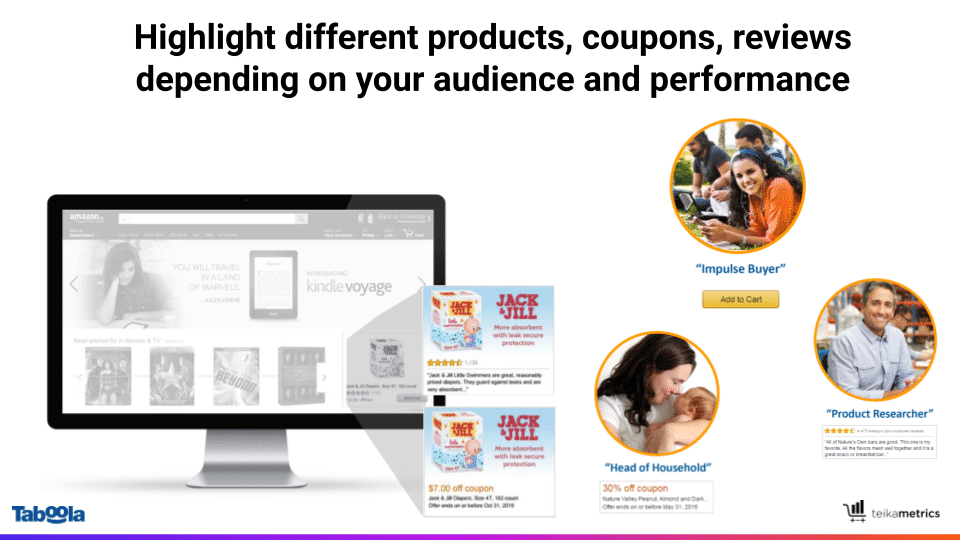As the ad ecosystem continues to evolve, it’s more important than ever to integrate all omnichannel advertising options into your strategy. Taboola recently partnered with Teikametrics on a webinar covering ways to grow your sales with integrated advertising. Titled “Growing Direct and Omnichannel Sales with Integrated Advertising,” the webinar featured insights from Ian Miller, DSP Lead at Teikametrics, and Mike Gifis, Director of North American Sales at Taboola.
Here are some of the key insights from that webinar:
1. Retail and digital media are converging
For some time, major retail platforms have been able to help brands and marketers reach their shoppers via digital channels. They’ve been able to leverage their customer data to provide information about both online and offline shopping behaviors.
Now, companies like Amazon, Walmart, and others are expanding their retail media offering. Many of them are developing their business through audience extension, which means using their data to target shoppers around the web or on social platforms. This will be a high-growth area for the foreseeable future, and creates more opportunities for e-commerce brands.

These platforms not only offer ways for marketers to drive transactions in real time based on their search products, but also to help their suppliers and brands drive awareness at an earlier stage of the funnel.
In the past few years, retail players have taken a big share of search ad revenue. In terms of market share, Amazon is already second only to Google, and Microsoft is also on the leaderboard.
“In the next few years, you’ll see retail media players represented more and more in terms of where search dollars and other digital ad dollars go.” – Mike Gifis, Director of North American Sales at Taboola
Don’t just focus on Amazon; consider other players to expand your opportunities to scale.
2. Inspiration can translate to sales
“The moment of inspiration is increasingly becoming the point of sale.” – Mike Gifis, Director of North American Sales at Taboola
Social commerce is growing. In the past year, 56.1 million people made a purchase directly from Facebook in the past year, and more than one in five people purchased a product discovered on a social platform.
Publishers aren’t slow to leverage this trend. For example, Bustle recently announced that their entire site is shoppable, and Shopify’s one-click checkout is available to any merchant on Google or Facebook. Focusing on the user is going to be very important for these publishers to succeed going forward.
3. Winning search is key
Whether you’re talking about a particular product category or branded terms, it’s hard to generate sales volume if you’re not winning search.
Advertising at the top of a search page is crucial, as most of the traffic is driven by the top three organic results on Amazon, as presented by Teikametrics during the webinar.

So, it’s key to explore how tools like Taboola can help you increase your organic rank, and improve your margins so you find the right balance between organic and paid sales.
4. Drive unique opportunities with onboarding
When looking at retail channels, often their user data is private. If you have an existing direct to consumer operation, a common tactic is onboarding those audiences to provide unique insights and drive targeted methodologies to grow your reach in front of the right audience.
This is a great alternative to relying on the shopper marketing audiences that the retail media platforms offer.
5. Translate targeting and creatives across platforms
When you expand to new channels, think critically about targeting and creative, and work with platform-specific experts where you can.
“The keyword strategies you use on Amazon won’t translate directly to other platforms. You have to put yourself in the users’ shoes and find what works best getting you in front of relevant audiences.” – Mike Gifis, Director of North American Sales at Taboola
This includes looking at differences in consumer mindset on different platforms, readership data trends, and more. It’s also important to diversify your criteria and use natural language processing to identify topics that might resonate with your audience across the web.

You also need to adjust your creative, based on the channel you’re using. Using Taboola’s trends data, you can tweak your copy by changing words in the headline, the CTA, the type of creative (for example, video vs. static image) to tap into the consumer’s mindset. You can fine tune your ad creatives down to distinguishing between which consumers prefer reviews and which would rather see a coupon code.
6. Use co-branding to leverage credibility with consumers
If your products are sold via a particular retail outlet, consider co-branding. That can help reinforce credibility and familiarity with the consumer at that moment of serving the ad. You can also drive more sales by setting a price point.
“One of the newest innovations is the ability for users to select the channel where they want to go next. This puts the decision in the user’s hands and removes some of that friction to purchase.” – Mike Gifis, Director of North American Sales at Taboola
7. Create custom audiences to drive traffic to your detail page
Custom audiences can help you target broader segments with Amazon DSP. For example, you’ll identify audiences who are looking for items similar to your products, and who have not yet made a purchase.
The goal is to drive those to your product detail page (or even your e-commerce site) so you can retarget them so they become familiar with your brand. That allows you to close the loop with a range of ad types. For example, you can show customer reviews. This is an awesome feature that can really drive traffic, and is better for customers who may not be as familiar with your product.

There are plenty of other insights to help you boost your sales in the full webinar recording. Watch now here!